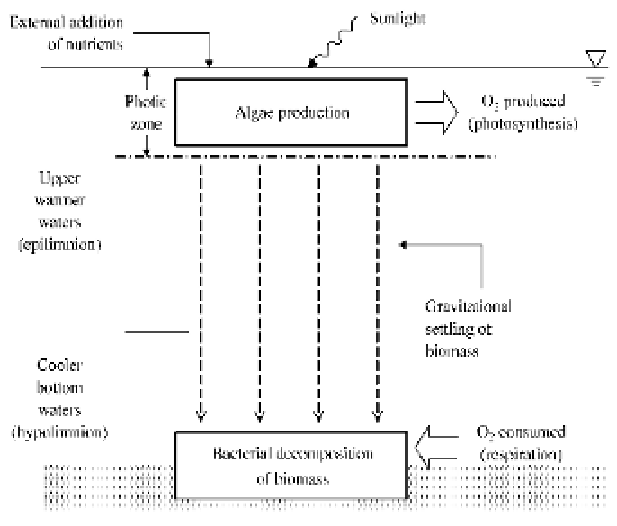Environmental Engineering Reference
In-Depth Information
Fig. 8.34
Photosynthetic production and bacterial consumption of oxygen in a stratified lake
Biological effects
—A number of biological changes may occur as a result of eutrophication: decreased
biodiversity, adverse community reaction, and changes in biomass and dominant species. For instance,
initially in an oligotrophic lake, the number of species of algae increases due to nutrient accumulation,
causing temporary increase in diversity of primary producers; however, as eutrophication proceeds,
specific bacteria become dominant, displacing many algal species. Some of these changes are indirect,
e.g., increased turbidity significantly reduces the light penetration in the water column, which negatively
impacts the survival of submerged plants relying on the sunlight for photosynthesis. Similarly, the fish
community may be indirectly affected and becomes dominated by some surface-dwelling coarse fishes
(e.g., cyprinid fish).
Fishkill
—Algal blooms in lakes and coastal waters are often accompanied by massive fish kills,
resulting in considerable economic loss and causing social concern and alarm. Extensive fish kills have
been reported in many countries world wide (Fig. 8.35). The fish kills are often related to either toxic
algal blooms or severe DO depletion. Although fishes can endure brief periods of reduced oxygen, they
begin to die if DO concentrations fall below about 2-3 mg/L. In addition, adverse environmental conditions
with low DO in the bottom waters results in the release of hydrogen sulphide (H
2
S) from sediments,
which is lethal to most fishes.
8.4.2
Causes of Eutrophication
Algal growth requires nutrients such as carbon, nitrogen, phosphorous, iron, manganese, boron, cobalt,
vitamins, and others. However, the limiting nutrients mainly held responsible for cultural eutrophication
are inorganic compounds of nitrogen or phosphorus. It is generally accepted that phosphorus is the
limiting nutrient in most inland waters, and nitrogen has been proven to be the limiting nutrient in most
coastal waters. Nitrogen and phosphorus come from many sources (Fig. 8.36): point sources of sewage
and industrial discharge along tributaries, non-point sources from agricultural areas in the drainage basin
or shores, pollution from aquaculture or mariculture zones, external loads from precipitation, and internal
loads released from sediment bed.


Search WWH ::

Custom Search